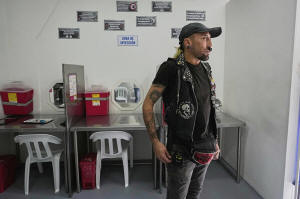Bogota fights heroin overdoses with South America's only supervised drug
consumption room
[April 28, 2025]
By ASTRID SUÁREZ
BOGOTA, Colombia (AP) — The left arm of Christian Camilo Amaya is
tattooed with a skull pierced by a syringe, which he says represents the
use of cocaine and heroin. He frequently shot up on streets of Bogota,
but he has recently switched to South America's only supervised room for
drug use, aimed at reducing harm and preventing overdoses.
Non-profit organization Accion Tecnica Social runs the supervised room
named Cambie (or Change in English) in Colombia's capital. Since it
opened in June 2023, 14 users had their overdoses treated with
injections of naloxone, a drug that reverses overdoses. The last such
case was a year ago.
Amaya often carries a black plastic bag with more than a dozen used
syringes, which he puts in a red container for biological waste, as
protocols for using the room dictate. He denies being addicted to
heroin, but argues the supervised room gives him syringes and training
on hygienic injections and overdose prevention.
“I know what substances do to me, so I know I shouldn’t be a frequent
user for that very reason, to avoid becoming addicted,” Amaya told The
Associated Press in the unmarked drug use room in one of the city’s
impoverished neighborhoods.
The initiative is one of the topics of the International Conference on
Harm Reduction, which started Sunday in Bogota. It is the first time the
conference has been held in Latin America in the past three decades, as
the leftist administration of President Gustavo Petro pushes for a
revision in the international drug control system of the United Nations.

The supervised consumption room currently has 87 registered users, 26%
of whom are Venezuelan migrants, who come to inject themselves or
receive syringes, food, guidance on lower-risk injection techniques, or
overdose management.
Of the users who come to the room, 91% use heroin, 7% inject cocaine,
and less than 2% use speedballs, a mixture of cocaine and heroin.
Official data on heroin use in Colombia is scarce.
[to top of second column]
|

Christian Amaya, a drug user, looks out the window of the Cambie
supervised consumption room in Bogotá, Colombia, Sunday, April 27,
2025, where people who use substances receive injection kits or
bring their own drugs while learning safe practices. (AP
Photo/Fernando Vergara)
 The project was born in 2022 when
organizers started contacting users directly to identify their
needs. It received technical advice from other countries, especially
Mexico.
For David Moreno, who works at Cambie, the most difficult part of
reversing an overdose is not injecting the naloxone but avoiding a
follow-up overdose.
“Once I had a user who would get very violent when she came back
from an overdose. She would start hurting herself, then she would
take off my jacket and tie it, and I’d have to restrain her,” said
Moreno.
“When it happens, I am calm. But when the user leaves... Wow, my
adrenaline rushes.”
Sam Rivera, the executive-director of OnPoint, a nonprofit
organization in New York City that operates supervised injection
centers, toured the small, nearly 65-foot room with three patient
cubicles before AP's visit.
“I look at it as a mini version of what we’re doing,” Rivera said.
He argues the initiative is also good for public security.
“I always tell people to come visit an overdose prevention center.
When you hear about it, it sounds dangerous or it sounds bad because
it sounds like you’re enabling people to use," he added. “These are
people who are going to use. So instead of using outside, in danger,
leaving these supplies in the street, everything happens inside,
everything stays inside.”
All contents © copyright 2025 Associated Press. All rights reserved |